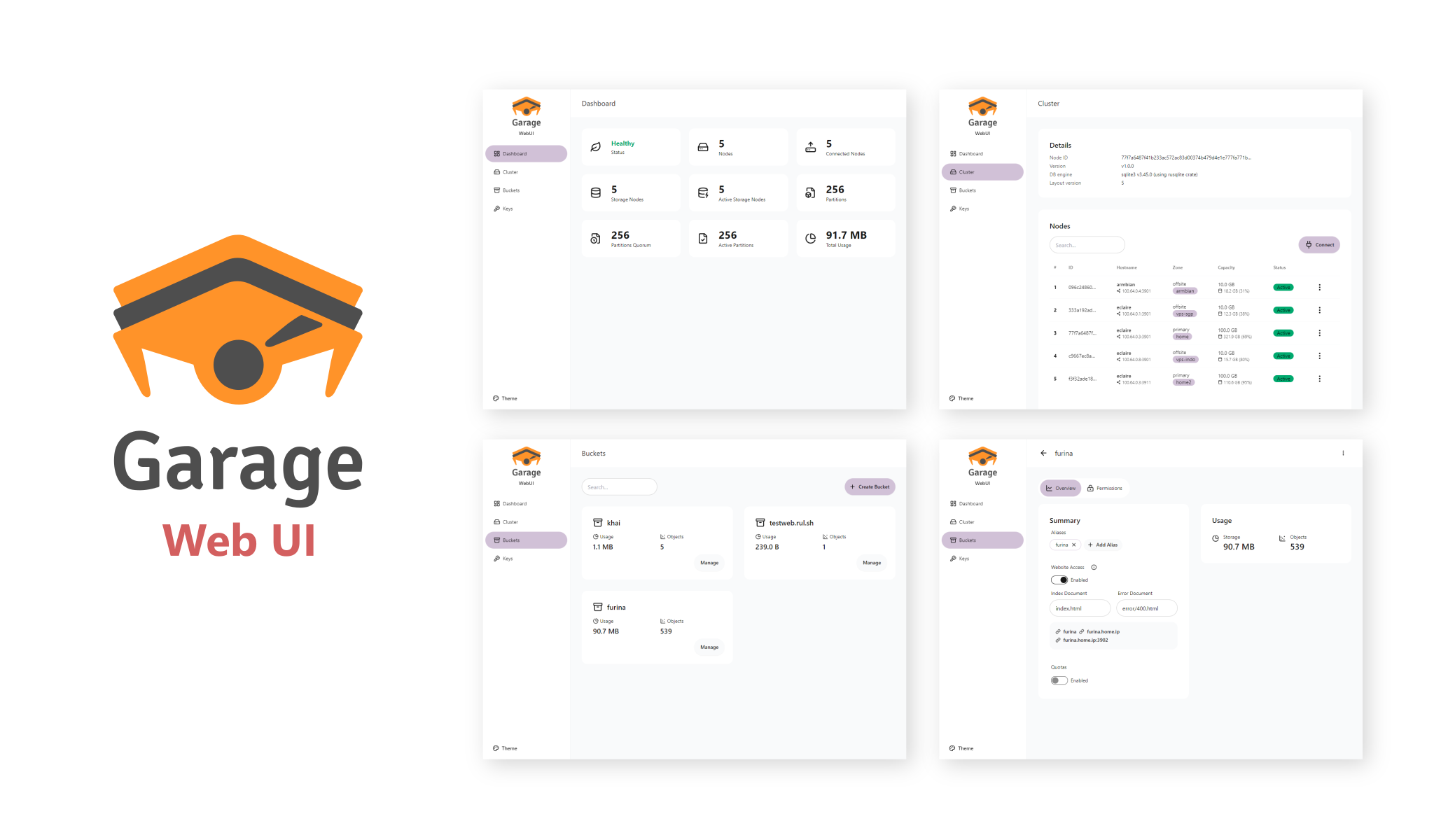6.8 KiB
Garage Web UI
A modern admin web UI for Garage v2, a self-hosted, S3-compatible, distributed object storage service.
Note
: This is version 2.0.0 of Garage Web UI, designed to work with Garage v2. If you're using Garage v1, please use the v1.x release of the Web UI instead.
This project is based on khairul169/garage-webui, the original Garage Web UI project. The v2 upgrade is maintained by Mohammad Raska (Adekabang).
[ Screenshots | Install Garage | Garage Git ]
Features
- Garage health status
- Cluster & layout management
- Create, update, or view bucket information
- Integrated objects/bucket browser
- Create & assign access keys
Installation
The Garage Web UI is available as a single executable binary and docker image. You can install it using the command line or with Docker Compose.
Docker CLI
docker run -p 3909:3909 -v ./garage.toml:/etc/garage.toml:ro --restart unless-stopped --name garage-webui adekabang/garage-webui:v2.0.0
Docker Compose
If you install Garage using Docker, you can install this web UI alongside Garage as follows:
services:
garage:
image: dxflrs/garage:v2.0.0
container_name: garage
volumes:
- ./garage.toml:/etc/garage.toml
- ./meta:/var/lib/garage/meta
- ./data:/var/lib/garage/data
restart: unless-stopped
ports:
- 3900:3900
- 3901:3901
- 3902:3902
- 3903:3903
webui:
image: adekabang/garage-webui:v2.0.0
container_name: garage-webui
restart: unless-stopped
volumes:
- ./garage.toml:/etc/garage.toml:ro
ports:
- 3909:3909
environment:
API_BASE_URL: "http://garage:3903"
S3_ENDPOINT_URL: "http://garage:3900"
Without Docker
Get the latest binary from the release page according to your OS architecture. For example:
wget -O garage-webui https://github.com/Adekabang/garage-webui/releases/download/2.0.0/garage-webui-v2.0.0-linux-amd64
chmod +x garage-webui
sudo cp garage-webui /usr/local/bin
Run the program with specified garage.toml config path.
CONFIG_PATH=./garage.toml garage-webui
If you want to run the program at startup, you may want to create a systemd service.
sudo nano /etc/systemd/system/garage-webui.service
[Unit]
Description=Garage Web UI
After=network.target
[Service]
Environment="PORT=3919"
Environment="CONFIG_PATH=/etc/garage.toml"
ExecStart=/usr/local/bin/garage-webui
Restart=always
[Install]
WantedBy=default.target
Then reload and start the garage-webui service.
sudo systemctl daemon-reload
sudo systemctl enable --now garage-webui
Configuration
To simplify installation, the Garage Web UI uses values from the Garage configuration, such as rpc_public_addr, admin.admin_token, s3_web.root_domain, etc.
Example content of garage.toml for Garage v2:
metadata_dir = "/var/lib/garage/meta"
data_dir = "/var/lib/garage/data"
db_engine = "sqlite"
replication_factor = 3
compression_level = 2
rpc_bind_addr = "[::]:3901"
rpc_public_addr = "localhost:3901" # Required for Web UI
rpc_secret = "YOUR_RPC_SECRET_HERE"
[s3_api]
s3_region = "garage"
api_bind_addr = "[::]:3900"
root_domain = ".s3.domain.com"
[s3_web] # Optional, if you want to expose bucket as web
bind_addr = "[::]:3902"
root_domain = ".web.domain.com"
index = "index.html"
[admin] # Required for Web UI
api_bind_addr = "[::]:3903"
admin_token = "YOUR_ADMIN_TOKEN_HERE"
metrics_token = "YOUR_METRICS_TOKEN_HERE"
However, if it fails to load, you can set API_BASE_URL & API_ADMIN_KEY environment variables instead.
Environment Variables
Configurable envs:
CONFIG_PATH: Path to the Garageconfig.tomlfile. Defaults to/etc/garage.toml.BASE_PATH: Base path or prefix for Web UI.API_BASE_URL: Garage admin API endpoint URL.API_ADMIN_KEY: Admin API key.S3_REGION: S3 Region.S3_ENDPOINT_URL: S3 Endpoint url.
Authentication
Enable authentication by setting the AUTH_USER_PASS environment variable in the format username:password_hash, where password_hash is a bcrypt hash of the password.
Generate the username and password hash using the following command:
htpasswd -nbBC 10 "YOUR_USERNAME" "YOUR_PASSWORD"
If command 'htpasswd' is not found, install
apache2-utilsusing your package manager.
Then update your docker-compose.yml:
webui:
....
environment:
AUTH_USER_PASS: "username:$2y$10$DSTi9o..."
Running
Once your instance of Garage Web UI is started, you can open the web UI at http://your-ip:3909. You can place it behind a reverse proxy to secure it with SSL.
Development
This project is bootstrapped using TypeScript & React for the UI, and Go for backend. If you want to build it yourself or add additional features, follow these steps:
Setup
git clone https://github.com/Adekabang/garage-webui.git
cd garage-webui && pnpm install
cd backend && pnpm install && cd ..
Development with Docker
For development with Docker, a docker-compose.dev.yml file is provided with 4 Garage v2 instances:
# Create necessary directories for Garage data
mkdir -p dev.local/data-garage/meta dev.local/data-garage/data
mkdir -p dev.local/data-garage2/meta dev.local/data-garage2/data
mkdir -p dev.local/data-garage3/meta dev.local/data-garage3/data
mkdir -p dev.local/data-garage4/meta dev.local/data-garage4/data
# Generate a secure RPC secret using OpenSSL
# The rpc_secret is used to secure communication between Garage nodes
RPC_SECRET=$(openssl rand -hex 32)
echo "Generated RPC secret: $RPC_SECRET"
# Copy the template configuration files and replace CONTAINER_NAME with the actual container name
# Using sed with empty string after -i for macOS compatibility
cp garage.toml.template dev.local/garage.toml && sed -i '' "s/CONTAINER_NAME/garage/g; s/dev-garage-secret/$RPC_SECRET/g" dev.local/garage.toml
cp garage.toml.template dev.local/garage2.toml && sed -i '' "s/CONTAINER_NAME/garage2/g; s/dev-garage-secret/$RPC_SECRET/g" dev.local/garage2.toml
cp garage.toml.template dev.local/garage3.toml && sed -i '' "s/CONTAINER_NAME/garage3/g; s/dev-garage-secret/$RPC_SECRET/g" dev.local/garage3.toml
cp garage.toml.template dev.local/garage4.toml && sed -i '' "s/CONTAINER_NAME/garage4/g; s/dev-garage-secret/$RPC_SECRET/g" dev.local/garage4.toml
# Setup environment variables
cp .env.example .env
cp backend/.env.example backend/.env
# Start the Garage containers
docker-compose -f docker-compose.dev.yml up -d
